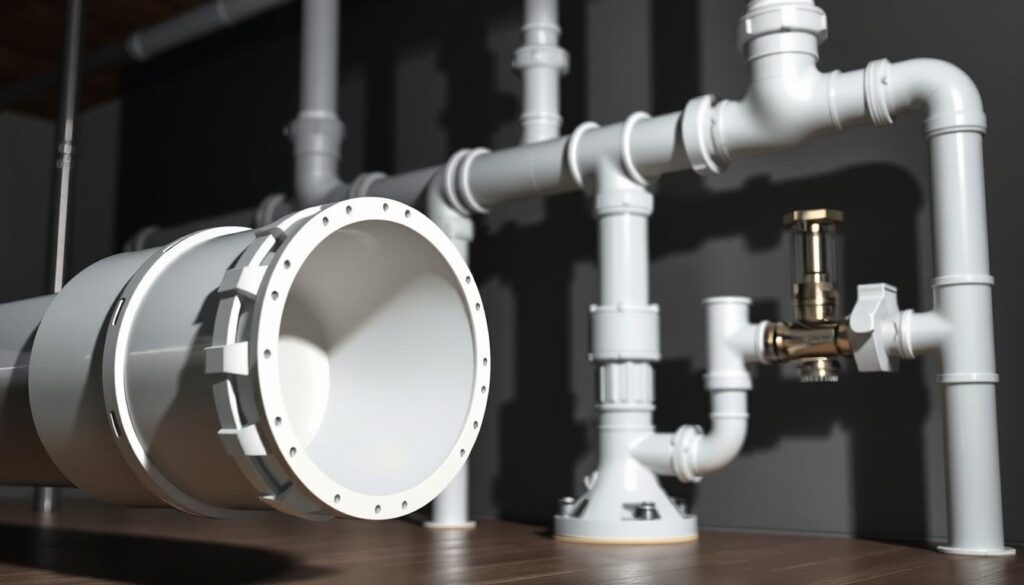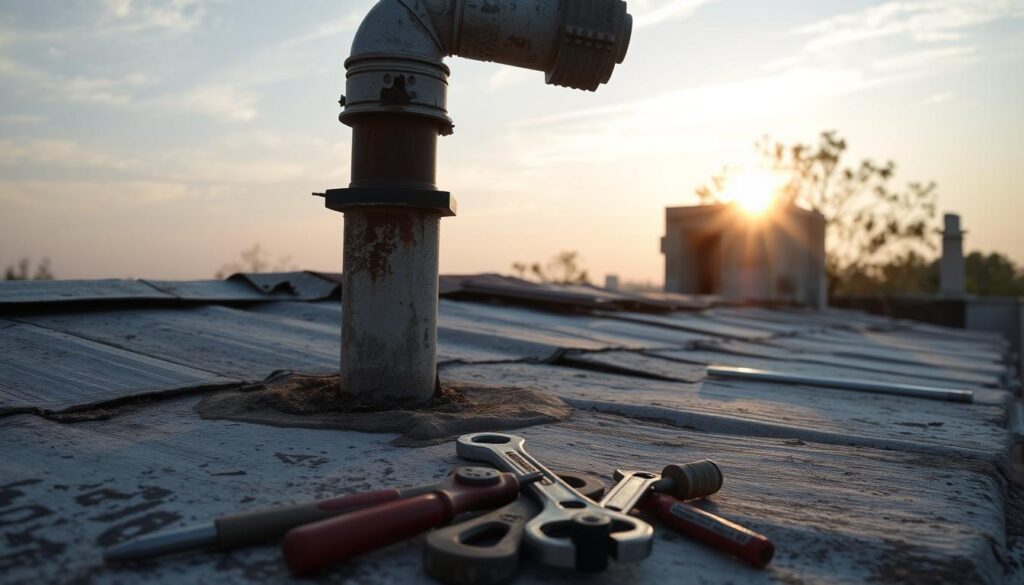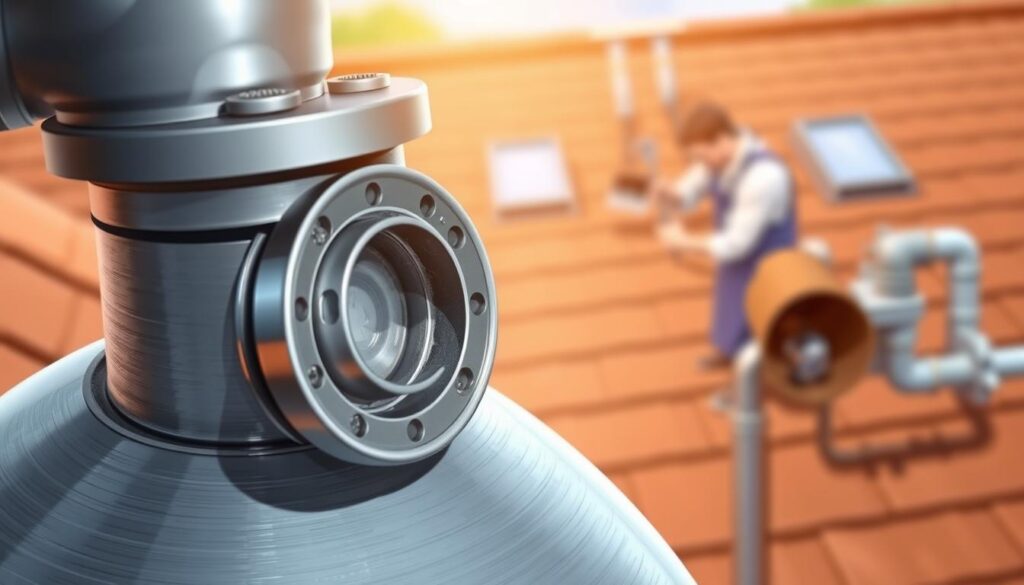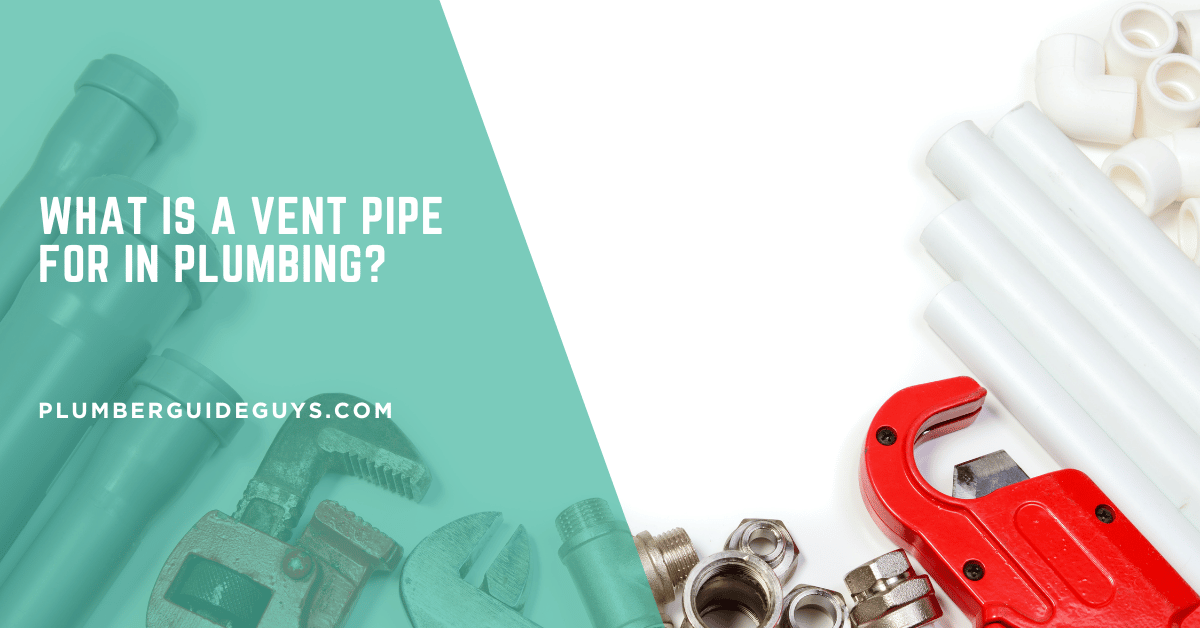Affiliate Disclosure
Plumber Guide Guys is a participant in the Amazon Services LLC Associates Program, an affiliate advertising program designed to provide a means for sites to earn advertising fees by advertising and linking to Amazon.
What is a Vent Pipe for in Plumbing? Ever wondered why your home’s plumbing doesn’t make weird sounds or smell bad when you flush or drain? It’s because of a small but key part called a plumbing vent pipe.

A plumbing vent pipe is vital for your home’s drainage system. It brings in fresh air to each fixture, keeping water flowing smoothly. Without it, your plumbing wouldn’t work well.
Knowing about vent pipes helps you see the amazing engineering behind your home’s water and waste system. These unsung heroes keep your plumbing running right, avoiding big problems.
Key Takeaways
- Vent pipes supply fresh air to plumbing fixtures
- They help regulate air pressure in drainage systems
- Prevent sewer gases from entering living spaces
- Support efficient water flow through pipes
- Essential for maintaining proper plumbing function
Understanding the Basics of Plumbing Vent Systems
Your home’s plumbing system is more complex than you might realize. The drain-waste-vent (DWV) system is key to keeping your plumbing working well. Knowing how plumbing vents work helps you see the design that prevents problems.
The DWV system explained is a network of pipes. It manages wastewater and keeps air flowing in your plumbing. Without these pipes, your drainage system would struggle a lot.
Key Components of Plumbing Ventilation
A typical plumbing ventilation system has several important parts:
- Vent stacks that go through the roof
- Branch vents that connect to fixtures
- Vent terminals that let air out
- Pipe connections all over the drainage system
Interaction Between Vent Pipes and Drainage
Vent pipes are a key part of your plumbing system. They let air move freely, stopping water from getting trapped and causing blockages. Think of them as breathing tubes for your home’s plumbing.
Air Pressure Dynamics in Plumbing
Keeping air pressure balanced is key for good drainage. Vent pipes help equalize pressure. This ensures water flows smoothly without vacuum effects that could slow down drainage or cause strange sounds.
Understanding the DWV system helps you see the engineering behind your home’s plumbing. It also lets you spot issues before they become big problems.
What is a Vent Pipe for in Plumbing?
Your home’s plumbing system has a key part that’s often overlooked: the plumbing vent pipe. It’s vital for keeping your drainage system healthy and working well. The vent pipe does more than just let air in.
The main job of the drain vent stack is to keep air pressure balanced in your plumbing. Without these pipes, your drains could act up and even be dangerous.
- Prevents sewer gases from entering your living spaces
- Equalizes air pressure in drain lines
- Allows wastewater to flow smoothly
- Eliminates possible blockages and slow drains
Think of your plumbing system as a big network of pipes. The vent pipe is like a breathing system. It makes sure water flows well and prevents vacuum problems. It’s like the lungs of your home’s plumbing system.
These pipes are usually put in through your roof and connect to your main drain line. They help sewer gases escape, keeping your home safe from bad smells and making it a healthier place.
The Critical Functions of Plumbing Vent Pipes
Plumbing vent pipes are key to a healthy home plumbing system. They are often overlooked but play a vital role. They help prevent issues that could affect your home’s comfort and safety.
Maintaining Proper Air Pressure
Vent pipes manage air pressure, which is essential. Without them, your plumbing system wouldn’t work right. They ensure the air pressure is balanced, letting water flow smoothly through your drains.
- Prevents vacuum formation in pipes
- Eliminates possible drainage blockages
- Ensures consistent water flow
Preventing Sewer Gas Buildup
Vent pipes also prevent sewer gas buildup. They offer a safe way for harmful gases to leave your home. This keeps you safe from dangerous and smelly gases.
| Potential Sewer Gas Risks | Vent Pipe Protection |
|---|---|
| Methane buildup | Safely redirects gases outside |
| Toxic hydrogen sulfide | Prevents indoor gas accumulation |
| Unpleasant odors | Maintains fresh indoor air quality |
Supporting Efficient Drainage Flow
Your home’s drainage system needs vent pipes to work well. They create a critical air channel that allows water to move freely through pipes. This prevents slow drains and backups, avoiding big plumbing problems.
Proper venting is the unsung hero of a well-functioning plumbing system.
Types of Plumbing Vent Pipes and Their Applications
Knowing about the different plumbing vent pipes is key to a good drainage system in your home. Plumbing stack venting helps manage air pressure. It also stops plumbing problems.
The main types of plumbing vent pipes are:
- True Vents: These are vertical pipes that go through the roof. They let air in and stop vacuum in drain lines.
- Common Vents: These are shared systems that connect many fixtures to one vent pipe. They save space and make installation easier.
- Re-Vent (Auxiliary) Pipes: These are smaller pipes for each fixture. They keep air pressure right and ensure good drainage.
- Air Admittance Valves (AAV): These are modern alternatives to traditional valves. They let air in without needing to go through the roof.
Air admittance valves are becoming more popular. They let air into the plumbing system but keep sewer gases out. They’re great when traditional venting is hard or not possible.
Each vent pipe has its own role in your plumbing system. The right choice depends on your home’s layout, local rules, and drainage needs.
Location and Installation of Vent Pipes
Proper vent pipe installation is key for a good plumbing system. Your home’s ventilation needs careful planning and precise execution. This ensures it works well and avoids problems.
Several important factors come into play for proper vent pipe installation. Knowing these will help you set up a reliable plumbing ventilation system. It must meet local building codes and work efficiently.
Roof Penetration Essentials
Vent pipes go through your roof, which is a critical connection for your plumbing system. The installation must be done carefully to avoid water damage and structural problems.
- Locate the optimal roof penetration point
- Use appropriate flashing to prevent leaks
- Ensure minimum six-inch pipe extension above the roof surface
- Seal all connections thoroughly
Distance Requirements from Fixtures
The placement of vent pipes near plumbing fixtures is very important. Each fixture needs specific venting to keep air pressure and drainage efficient.
Building Code Considerations
Local building codes have specific rules for vent pipe installation. Compliance is not optional – it’s vital for:
- Ensuring system safety
- Preventing health hazards
- Maintaining proper drainage
- Avoiding legal and insurance issues
Getting professional advice can help with the complexities of local plumbing rules. It ensures your vent pipe installation meets all standards.
Common Problems with Plumbing Vent Systems
Plumbing vent pipe problems can cause big headaches for homeowners. They can mess up your drainage system and even pose health risks if ignored.

Your home’s plumbing vent system is key for good drainage and keeping sewer gases out. Several common issues can harm this system:
- Blockages from debris, leaves, or animal nests
- Bad installation that hinders air flow
- Damage from harsh weather
- Corrosion or wear and tear on vent pipes
It’s important to spot signs of plumbing vent pipe problems early. Persistent gurgling sounds, slow drainage, and bad sewer smells mean there’s a problem.
“A blocked vent pipe can turn your home’s plumbing into a nightmare of inefficient drainage and possible health hazards.”
Each type of vent pipe problem needs a specific fix:
| Problem Type | Potential Consequences | Recommended Action |
|---|---|---|
| Complete Blockage | Total drainage system failure | Immediate professional inspection |
| Partial Obstruction | Slow drainage, possible backups | Professional cleaning or repair |
| Pipe Damage | Leaks, possible structural damage | Pipe replacement or repair |
While some problems can be spotted by homeowners, a pro’s check is best. It ensures the right fix and avoids long-term plumbing damage.
Signs of a Malfunctioning Vent Pipe
Your plumbing vent pipe is key to your home’s drainage. Spotting early signs of trouble can stop bigger problems and health risks.
Knowing how plumbing vents work helps spot issues. A good vent pipe keeps air pressure right and waste flows well.
Drainage Issues and Gurgling Sounds
Look out for these signs if your vent pipe is off:
- Slow or gurgling drains
- Bubbling sounds when water tries to drain
- Water draining inconsistently or backing up
Sewer Odors and Gas Problems
A blocked vent can lead to bad smells and gas issues:
- Persistent foul smells near drains
- Sulfur-like odors in bathrooms or kitchen
- Potential health risks from trapped sewer gases
Water Level Fluctuations
Odd water behaviors in toilets and sinks mean vent pipe trouble:
- Toilet water rising or falling unexpectedly
- Empty toilet tanks after flushing
- Inconsistent water levels in sink fixtures
Pro tip: If you see many symptoms, call a pro plumber to check your vent pipe.
Maintenance and Care of Plumbing Vent Pipes

Keeping your plumbing vent pipes in good shape is key to a smooth drainage system. If you ignore these parts, you could face big plumbing problems.
Regular checks are vital for plumbing vent pipe care. Do visual inspections at least twice a year to catch issues early.
- Inspect roof penetrations for signs of damage
- Check for visible blockages or debris
- Look for possible animal nests or obstructions
- Examine pipe connections for leaks or corrosion
Focus on these areas during maintenance:
| Maintenance Area | Recommended Action | Frequency |
|---|---|---|
| Roof Vent Opening | Clear debris and remove possible blockages | Twice yearly |
| Pipe Connections | Check for tight seals and signs of wear | Annually |
| Interior Vent Sections | Inspect for leaks or damage | Every 18 months |
Pro tip: Homeowners can handle some tasks, but complex issues need a pro. If you see ongoing drainage issues or odd sounds, call a licensed plumber.
Preventive steps can cut down on maintenance needs. Trim trees near roof vents and avoid harsh cleaners that can harm pipes.
Professional Repairs vs. DIY Solutions
Homeowners often debate whether to fix plumbing vent pipe issues themselves or hire a pro. Knowing when to DIY can save you money and prevent damage to your plumbing.
For minor problems, you might be able to fix the vent pipe with basic tools. Simple blockages or small leaks can be handled with some effort and the right tools.
- Inspect the vent pipe for visible damage
- Check for obvious blockages
- Use basic plumbing tools for minor repairs
But for more complex issues, a professional plumber is your best bet. They have the skills to diagnose and fix problems that go beyond simple fixes.
| DIY Repair | Professional Repair |
|---|---|
| Low cost | Comprehensive diagnosis |
| Simple maintenance tasks | Advanced technical skills |
| Limited tool access | Specialized equipment |
It’s important to know when to call a plumber for plumbing vent pipe repair. If you have ongoing drainage issues, strange noises, or suspect major damage, it’s time to get a pro.
Safety and long-term functionality should always take precedence over short-term cost savings.
While some DIY tasks are okay, complex repairs need a pro. This ensures your plumbing system works well and lasts long.
The Role of Air Admittance Valves as Alternative Venting
Plumbing air admittance valves (AAVs) are a new way to solve old venting problems. They are used in homes and businesses. These devices are a better choice than old roof vents, making plumbing systems work better.
Air admittance valves are clever. They let air into the plumbing when water flows. This stops air pressure problems that slow down drainage. When the water stops, the valve closes, keeping bad smells out.
Key Benefits of Plumbing Air Admittance Valves
- Reduced roof penetrations
- Simplified installation process
- Cost-effective venting solution
- Minimized heat loss
- Versatile application in various plumbing configurations
Installation Requirements
Putting in air admittance valves needs careful thought. You must place them right, follow local rules, and meet the maker’s guidelines.
| Consideration | Requirement |
|---|---|
| Minimum Distance from Fixture | 4 inches |
| Maximum Vertical Distance | 24 inches |
| Accessibility | Must be accessible for maintenance |
Even with many benefits, air admittance valves aren’t for every place. Some places have rules against them. Always talk to a pro plumber or building inspector before you start.
Pro tip: Always check local rules and get the right permits before using air admittance valves in your plumbing.
Conclusion
Plumbing vent pipes are key to a healthy home drainage system. Our article on the DWV system shows how these pipes keep your home safe. By knowing the importance of vent pipes, you can avoid expensive fixes and keep your home draining well.
Your home’s plumbing is a complex system that needs care. Vent pipes do more than let air in – they keep you safe from bad sewer smells, stop drainage problems, and keep air pressure right. Regular checks and maintenance can spot issues early, avoiding big plumbing troubles.
Smart homeowners know that knowing about their systems is powerful. Learning about your DWV system helps you make smart choices about upkeep, fixes, and upgrades. Whether you tackle small tasks yourself or call a pro, knowing about vent pipes saves you time, money, and stress.
Your home’s plumbing is a big investment. Take the time to learn about it, watch for signs of trouble, and fix problems fast. A well-kept plumbing system with working vent pipes keeps your home comfy, safe, and free from plumbing surprises.

